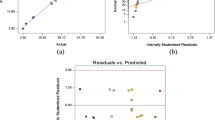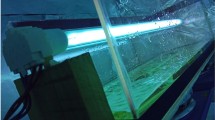Abstract
The influence of structure on degradation of five halogenated phenols (XPs) by UV/H2O2 process was investigated. The combined influence of type or number of substituents and UV/H2O2 process parameters (pH and [H2O2]) on the degradation kinetics of 2-fluorophenol (2-FP), 2-chlorophenol (2-CP), 2-bromophenol (2-BP), 2,4-dichlorophenol (2,4-DCP), and 2,4,6-trichlorophenol (2,4,6-TCP) was studied using modified miscellaneous 33 full factorial design and response surface modeling (RSM). Studied XPs obey first-order degradation kinetics within the investigated range of process parameters. Determined degradation rate constants (k obs) were correlated with process and structural parameters by the quadratic polynomial models. Analysis of variance (ANOVA) demonstrated RSM models’ accuracy and showed that, in addition to pH and [H2O2], model terms related with the pollutant structure are highly influential. k obs of mono-XPs follow the decreasing order 2-FP, 2-CP, and 2-BP, while CPs follow the decreasing order 2-CP, 2,4-DCP, and 2,4,6-TCP. Biodegradability (biochemical oxygen demand (BOD)5/chemical oxygen demand (COD)) and toxicity (TU) were evaluated prior to the treatment and at the reference time intervals. The observed differences are correlated with the structural characteristics of studied XPs.






Similar content being viewed by others
References
Adams, C. D., Scanian, P. A., & Secrist, N. D. (1994). Oxidation and biodegradability enhancement of 1,4-dioxane using hydrogen peroxide and ozone. Environmental Science and Technology, 28, 1812–1818.
Alnaizy, R., & Akgerman, A. (2000). Advanced oxidation of phenolic compounds. Advances in Environmental Research, 4(3), 233–244.
Beltran, F. J. (2003). Ozone-UV radiation-hydrogen peroxide oxidation technologies. In M. A. Tarr (Ed.), Chemical degradation methods for wastes and pollutants, environmental and industrial applications (pp. 1–75). New York: Marcel Dekker.
Benitez, F. J., Beltran-Heredia, J., Acero, J. L., & Rubio, F. J. (2000). Contribution of free radicals to chlorophenols decomposition by several advanced oxidation processes. Chemosphere, 41, 1271–1277.
Benitez, F. J., Beltran-Heredia, J., Acero, J. L., & Rubio, F. J. (2001). Oxidation of several chlorophenolic derivatives by UV irradiation and hydroxyl radicals. Journal of Chemical Technology and Biotechnology, 76, 312–320.
Box, G. E. P., & Cox, D. R. (1964). An analysis of transformations. Journal of the Royal Statistical Society: B Statistical Methodology, 26, 211–246.
Burrows, H. D., Canle, L. M., Santaballa, J. A., & Steenken, S. (2002). Reaction pathways and mechanisms of photodegradation of pesticides. Journal of Photochemistry and Photobiology B: Biology, 67, 71–108.
Buxton, G. V., Greenstock, C. L., Helman, W. P., & Ross, A. B. (1988). Critical review of rate constants for reactions of hydrated electrons, hydrogen atoms and hydroxyl radicals (•OH/•O−) in aqueous solution. Journal of Physical and Chemical Reference Data, 17, 513–586.
Calza, P., Massolino, C., & Pelizzetti, E. (2008a). Photo-induced transformation of hexaconazole and dimethomorph over TiO2 suspension. Journal of Photochemistry and Photobiology A: Chemistry, 200, 356–363.
Calza, P., Massolino, C., Pelizzetti, E., & Minero, C. (2008b). Solar driven production of toxic halogenated and nitroaromatic compounds in natural seawater. Science of the Total Environment, 398(1–3), 196–202.
ChemSpider (2013). Search and share chemistry. http://www.chemspider.com/Chemical-Structure.9326.html?rid=f87e5bbe-2a3d-4333-8380-0dea4d837c93). Accessed 30 Nov 2013.
Connors, K. A. (1990). Chemical kinetics: the study of reaction rates in solution. New York: Wiley-VCH.
Cunningham, W. P., Cunningham, M. A., & Saigo, B. (2005). Environmental science, a global concern. New York: Mc Graw-Hill Education.
Czaplicka, M. (2006). Photo-degradation of chlorophenols in the aqueous solution. Journal of Hazardous Materials, B134, 45–59.
European Commission. (2001). EC Decision 2455/2001/EC of the European Parliament and of the Council of November 20, 2001 establishing the list of priority substances in the field of water policy and amending Directive 2000/60/EC (L 331 of 15-12-2001)
EEC. (1993). Commission Directive 93/67/EEC of 20 July 1993 laying down the principles for the assessment of risks to man and the environment of substances notified in accordance with Council Directive 67/548/EEC. Official Journal of European Communities, 227, 9–17.
EPA, July 2002, http://www.scorecard.org
Farré, M. J., Franch, M. I., Ayllón, J. A., Peral, J., & Domènech, X. (2007). Biodegradability of treated aqueous solutions of biorecalcitrant pesticides by means of photocatalytic ozonation. Desalination, 211, 22–33.
Gaya, U. I., Abdullah, A. H., Zainal, Z., & Hussein, M. Z. (2010). Photocatalytic degradation of 2,4-dichlorophenol in irradiated aqueous ZnO suspension. International Journal of Chemistry, 2(1), 180–193.
Getoff, N., & Solar, S. (1986). Radiolysis and pulse radiolysis of chlorinated phenols in aqueous solutions. Radiation Physics and Chemistry, 28, 443–450.
Gogate, P. R., & Pandit, A. B. (2004). A review of imperative technologies for wastewater treatment I: oxidation technologies at ambient conditions. Advances in Environmental Research, 8, 501–551.
International Standard ISO 11348-3 (1998). Water quality—determination of the inhibitory effect of water samples on the light emission of Vibrio fischeri (luminescent bacteria test).
Jennings, V. L. K., Rayner-Brandes, M. H., & Bird, D. J. (2001). Assessing chemical toxicity with the bioluminescent photobacterium (Vibrio fischeri): a comparison of three commercial systems. Water Research, 35, 3448–3456.
Kralik, P., Kusic, H., Koprivanac, N., & Loncaric Bozic, A. (2010). Degradation of chlorinated hydrocarbons by UV/H2O2: the application of experimental design and kinetic modeling approach. Chemical Engineering Journal, 158, 154–166.
Kusic, H., Koprivanac, N., & Loncaric Bozic, A. (2006). Minimization of organic pollutant content in aqueous solution by means of AOPs: UV- and ozone-based technologies. Chemical Engineering Journal, 123(3), 127–137.
Kusic, H., Rasulev, B., Leszczynska, D., Leszczynski, J., & Koprivanac, N. (2009). Prediction of rate constants for radical degradation of aromatic pollutants in water matrix: a QSAR study. Chemosphere, 75(8), 1128–1134.
Kusic, H., Juretic, D., Koprivanac, N., Marin, V., & Loncaric Bozic, A. (2011). Photooxidation processes for an azo dye in aqueous media: modeling of degradation kinetic and ecological parameters evaluation. Journal of Hazardous Materials, 185, 1558–1568.
Kusic, H., Koprivanac, N., Papic, S., & Loncaric Bozic, A. (2012). Influence of substituent type and position on photooxidation of phenolic compounds: response surface methodology approach. Journal of Photochemistry and Photobiology A: Chemistry, 242, 1–12.
Liao, H., & Reitberger, T. (2013). Generation of free OHaq radicals by black light illumination of Degussa (Evonik) P25 TiO2 aqueous suspensions. Catalysts, 3, 418–443.
Mantzavinos, D., & Psillakis, E. (2004). Enhancement of biodegradability of industrial wastewaters by chemical oxidation pre-treatment. Journal of Chemical Technology and Biotechnology, 79, 431–454.
Metz, D. H., Meyer, M., Dotson, A., Beerendonk, E., & Dionysiou, D. D. (2011). The effect of UV/H2O2 treatment on disinfection by-product formation potential under simulated distribution system conditions. Water Research, 45, 3969–3980.
Myer, R. H., & Montgomery, D. C. (2002). Response surface methodology: process and product optimization using designed experiment. New York: Wiley.
National Library of Medicine HDSB Database, Toxicology Data Network (TOXNET) - Accessed on November 29, 2013 (http://toxnet.nlm.nih.gov/cgi-bin/sis/search/a?dbs+hsdb:@term+@DOCNO+7648)
Nicole, I., De Laat, J., Dore, M., Duguet, J. P., & Bonnel, C. (1990). Utilisation du rayonnement ultraviolet dans le traitement des eaux: mesure du flux photonique par actinometrie chimique au peroxyde d’hydrogene (Use of U.V. radiation in water treatment: measurement of photonic flux by hydrogen peroxide actinometry). Water Research, 24(2), 157–168.
Nogueira, R. F. P., Oliveira, M. C., & Paterlini, W. C. (2005). Simple and fast spectrophotometric determination of H2O2 in photo-Fenton reactions using metavanadate. Talanta, 66(1), 86–91.
Parsons, S. (2004). Advanced oxidation processes for water and wastewater treatment. London: IWA Publishing.
Peller, J., & Kamat, P. V. (2005). Radiolytic transformations of chlorinated phenols and chlorinated phenoxyacetic acids. Journal of Physical Chemistry A, 109, 9528–9535.
Pera-Titus, M., Garcia-Molina, V., Banos, M. A., Gimenez, J., & Esplugas, S. (2004). Degradation of chlorophenols by means of advanced oxidation processes: a general review. Applied Catalysis B: Environmental, 47, 219–256.
Pichat, P. (2003). Photocatalytic degradation of pollutants in water and air: basic concepts and applications. In M. A. Tarr (Ed.), Chemical degradation methods for wastes and pollutants, environmental and industrial applications (pp. 77–119). New York: Marcel Dekker Inc.
Reineke, N., Biselli, S., Franke, S., Francke, W., Heinzel, N., Huhnerfuss, H., et al. (2006). Brominated indoles and phenols in marine sediment and water extracts from the North and Baltic seas—concentrations and effects. Archives of Environmental Contamination and Toxicology, 51, 186–196.
Roig, B., Gonzalez, C., & Thomas, O. (2003). Monitoring of phenol photodegradation by ultraviolet spectroscopy. Spectrochimica Acta: A Molecular and Biomolecular Spectroscopy, 59(2), 303–307.
Rosal, R., Palomares, I. R., Boltes, K., Fernández-Pińas, F., Leganés, F., & Petre, A. (2010). Ecotoxicological assessment of surfactants in the aquatic environment: combined toxicity of docusate sodium with chlorinated pollutants. Chemosphere, 81, 288–293.
Sarria, V., Parra, S., Adler, N., Péringer, P., Benitez, N., & Pulgarin, C. (2002). Recent developments in the coupling of photoassisted and aerobic biological processes for the treatment of biorecalcitrant compounds. Catalysis Today, 76, 301–315.
Sim, W.-J., Lee, S.-H., Lee, I.-S., Choi, S.-D., & Oha, J.-E. (2009). Distribution and formation of chlorophenols and bromophenols in marine and riverine environments. Chemosphere, 77, 552–558.
Sinclair, G. M., Paton, G. I., Meharg, A. A., & Killham, K. (1999). Lux-biosensor assessment of pH effects on microbial sorption and toxicity of chlorophenols. FEMS Microbiology Letters, 174, 273–278.
Stat-Ease (2008). Multifactor RSM tutorial (part 2—optimization), design-expert software version 7.1.5 user’s guide.
Steenken, S., & Neta, P. (2003). Transient phenoxyl radicals: formation and properties in aqueous solutions. In Z. Rappoport (Ed.), The chemistry of phenols (Vol. Part 2, pp. 1107–1152). England: John Wiley and Sons Ltd.
Turchi, C. S., & Ollis, D. F. (1990). Photocatalytic degradation of organic water contaminants: mechanisms involving hydroxyl radical attack. Journal of Catalysis, 122, 178–192.
Zak S. (2008). Problem of correction of the chemical oxygen demand values determined in wastewaters treated by methods with hydrogen peroxide. Proceedings of 17. CEC ECOpole’08, Piechowice, Poland, pp. 409–414.
Acknowledgments
We gratefully acknowledge the financial support from the University of Zagreb, Republic of Croatia (Project No. 110005).
Author information
Authors and Affiliations
Corresponding authors
Electronic Supplementary Material
Below is the link to the electronic supplementary material.
ESM 1
(DOC 765 kb)
Rights and permissions
About this article
Cite this article
Juretic, D., Puric, J., Kusic, H. et al. Structural Influence on Photooxidative Degradation of Halogenated Phenols. Water Air Soil Pollut 225, 2143 (2014). https://doi.org/10.1007/s11270-014-2143-2
Received:
Accepted:
Published:
DOI: https://doi.org/10.1007/s11270-014-2143-2




